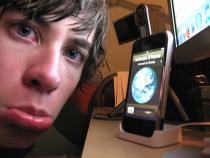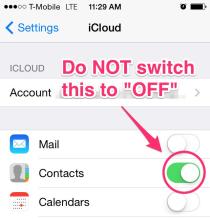Do NOT Touch This Button On Your iPhone Or Apple Will Delete All Your Contacts
Many people prefer Apple's iPhone to Android phones for two reasons: The iPhone is simple to use and ultra-reliable.
Android, by contrast, can sometimes be a little tricky if you're not the most technically minded person. Contacts in Android can be complicated — it pulls contacts from all sorts of different databases and you end up with a ton of duplicated contacts unless you sit down and learn how to manage them.
So if you want simple contacts, iPhone is the way to go.
But the iPhone also has a huge danger area when it comes to questionable contacts management: iCloud.
iCloud, Apple's storage and backup system, will delete all the contacts on your iPhone if you make one wrong step inside your iPhone's settings. I discovered this myself recently, to my horror. It is the ultimate smartphone nightmare. I was innocently picking through my phone's "settings" section, trying to figure out how to free up enough space on my phone to accept Apple's latest operating system update when suddenly ... all the contact info for everyone I know just disappeared.
Everyone — gone.
I couldn't even call my mom (she just moved and got a new phone number).
My tech blogger colleagues will be laughing at me for this, I realize. We're supposed to know how a phone works. But the problem with iCloud is that it works in such a counterintuitive way that even among Apple fans, people avoid using iCloud or don't understand it.
iCloud is the Apple system that keeps backups of all the data and files you want. You can preserve your music and email in iCloud if you want. But for contacts, iCloud works slightly differently than other types of cloud backups.
Many cloud backup systems work by uploading a copy of the file on your device into the cloud. So the "real" file you care about is on your device; if you lose it there will be a copy in the cloud. (Carbonite works this way; Dropbox's main innovation was to not have duplicate real/cloud files — the file is either on your device or in the Dropbox cloud, but not both at the same time.)
When it comes to your iPhone contacts and iCloud, however, the reverse is true. If you've got iCloud backup for your contacts switched on, your iPhone contacts are stored in iCloud, NOT on your phone.
So if you switch that off, they all get deleted.
Trust me, it's a nightmare. The good news is that your contacts come back if you switch iCloud back on again. But that only means your contacts are trapped inside iCloud — they're not actually on your phone.
Here is how to avoid deleting your iPhone contacts via iCloud:
1. Go into Settings.
2. Go into iCloud.
Jim Edwards / BI
The one button you should not touch on your iPhone.
3. Look but do NOT touch the "Contacts" setting for iCloud.
4. If iCloud is "off" for contacts — i.e. the slider is white — and your contacts are all still on your phone, then this means your contacts are stored only on your phone. This is great — unless you break your phone. Then your contacts are gone forever. You have no backup.
5. If iCloud is "on" for contacts — i.e. the slider is green — then your contacts are actually living in iCloud. If you switch iCloud off they will disappear from your phone. This means your contacts are trapped inside iCloud. This is great if you want to get a new Apple device — those contacts will magically transfer when you sign in.
6. If you do move the slider from on to off (green to white) then you'll be asked whether you want your contacts deleted or stored locally on your phone. Obviously do NOT delete your contacts. If you want them unhooked from iCloud, store them locally on the phone.
Bottom line: Apple has a function in its settings that will wipe out your contacts if you make a wrong move. This seems like a crazy thing to have on a phone, but there it is.
If your contacts button in iCloud looks like this (above) then do NOT touch it! That's because it's too late — your contacts are in iCloud and you're mostly stuck there.
More From Business Insider



